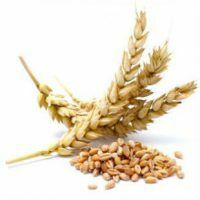
Many people suffer from serious inherited autoimmune disorders, which include celiac disease or intolerance to the protein gluten contained in certain foods. The only way to treat this disease is to follow a special diet based on gluten-free foods, the list of which is given below.
When a person enters the stomach with celiac disease even microscopic doses of gluten, the immune system attacks and destroys the tissues of the small intestine, provoking inflammation. To start the reaction, it is enough about 0.1 gram of gluten, and in food it is much more, for example, in a piece of white bread - 4-5 grams, in a portion of pasta - 6-7 grams.
- What is gluten?
- Symptoms of intolerance in adults and children
- Product list
What is gluten
Gluten is a complex plant protein found in some cereals( wheat, rye, barley, often oats), also known as gluten. Accordingly, it is contained in all foods that are prepared using these cereals.
The reaction continues all the time, while the person consumes products with gluten.
Symptoms of intolerance in adults and children
People of different ages exhibit different symptoms of celiac disease, and total number is about 300. This is due to the fact that disruption of the bowels, which provides the body with all the necessary nutrients, can disrupt the work of anyan internal organ not directly related to the digestive system.
As a result, not the underlying disease is diagnosed and treated, but secondary disorders.
In infants, symptoms are manifested, as a rule, when supplementing foods with gluten content: wheat and semolina porridge, biscuits, etc., and they can appear in the period from a couple of days to several weeks after the start of feeding with new products. The main symptoms of intolerance are:
- constant bloating, colic;
- a long, watery stool with an extremely unpleasant odor, foam, mucus, a greenish tinge;
- alternating diarrhea with constipation;
- frequent regurgitation, recurrent vomiting;
- appearance of herpetiform dermatitis - itchy red vesicles on the body;
- pale skin;
- decreased appetite, refusal to eat, poor gain or weight loss;
- cardinal behavioral disorder: persistent anxiety or prolonged sleepiness.
Symptoms of gluten intolerance in preschool children in the main body coincide with its signs in infants with respect to digestive disorders, dermatitis and a lag in growth and development.
In addition to typical digestive disorders for children, adolescents may also show symptoms that are not at first glance related to celiac disease:
- anemia due to inability to digest iron from food;
- delay in puberty due to impaired hormone production;
- low height - less than 155 cm for girls and 165 cm for boys;
- herpetiform dermatitis in the form of a bubble itchy rash on the elbows, knees, buttocks;
- hypoplasia or underdevelopment of tooth enamel;
- inflammation of the liver;
- juvenile or juvenile osteoporosis;
- a variety of disorders of the nervous system( epilepsy, depression, panic attacks, back and joint pain), which are not amenable to conventional treatment.
The most common symptoms of gluten intolerance in adults are:
- flatulence with abdominal pain;
- stinking stool, often with blood;
- alternating diarrhea with constipation;
- nausea and vomiting;
- iron deficiency anemia, which can not be treated with drugs;
- in women - menstrual irregularities and difficulties with conceiving and bearing a child;
- problems with the liver;
- increased fatigue and other disorders associated with a lack of vitamins;
- herpetiform dermatitis;
- ulcers on the oral mucosa;
- joint pain;
- osteopenia and osteoporosis;
- mental disorders.
List of products
People with gluten intolerance should completely eliminate from food:
- wheat and rye bread;
- pasta;
- baking and biscuits;
- cereals and breakfast cereals containing wheat, rye, barley;
- any dishes, including wheat and rye flour;
- semi-finished products and prepared meat products containing gluten additives, for example, hydrolyzed wheat protein, wheat starch, flavors, colorants;
- beer and non-distilled vodka;
- prepared sauces, broth cubes, powdered soups and purees;
- all dishes in breading or marinade.
Based on the following products, you can diversify and fully formulate your diet:
- buckwheat, corn, rice, soybean, oatmeal( gluten-free) flour, corn, potato starch;
- more exotic for our region types of flour from almonds, chickpeas, sorghum, tapioca, amaranth;
- rice, buckwheat noodles;
- dairy products with good lactose tolerance: milk, cream, sour cream, cottage cheese, cheese, brynza, yoghurt;
- vegetable and butter;
- a variety of vegetables, fruits and berries;
- legumes, sorghum, various rice varieties;
- nuts and seeds in kind;
- meat, poultry, fish without marinade and breading;
- fresh eggs;
- dried apricots, raisins, prunes and other dried fruits;
- juices, teas, compotes;
- from alcohol you can use wine, whiskey, tequila, rum, gin, bourbon.
